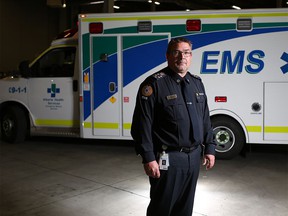
Article content
Health-care workers have been under extreme strain combating COVID-19, and paramedics are no exception.
Advertisement 2
Article content
Emergency Medical Services (EMS) crews in Alberta have been on the front lines of the pandemic, and now they’re also under the pressure of stubbornly high call volumes, prompting Alberta Health Services to develop a new plan to help them cope with the stress .
Postmedia spoke with Alberta’s Chief Paramedic, Darren Sandbeck, about what ambulance crews are facing now, and how health authorities are responding.
-
Opinion: EMS making changes to make sure ambulances are there when needed
-
Alberta releases EMS plan as paramedic demand reaches all-time high
How have EMS call volumes changed over the pandemic?
Pre-pandemic, our call volumes were increasing in the projected range of five to six per cent a year. What we saw that we really can’t explain — and it’s actually an international phenomenon — is in about February of 2021, our call volumes really began to spike and we saw up to 30 per cent increases in call volumes.
advertisement 3
Article content
We saw this across the province, in all communities, and across all of our call types. We couldn’t tie it back to any one type of call that was increasing, it was a systemic 30 per cent increase to our call volume.
Are there theories about what’s happening?
We think that some of it was probably tied to the health system reopening and coming back online. We think that part of it was probably tied to people becoming more mobile again when we sort of emerged between waves.
Some of it we can relate to the opioid crisis to some degree, but it’s really a puzzle. When we talk to colleagues, EMS systems around the world are actually saying exactly the same thing.
How has the opioid crisis and high rates of drug poisonings affected paramedics?
advertisement 4
Article content
Predominantly our metro crews do see a pretty high number of opioid calls. And in the time that we’re busy with everything else, those are busy too. The fatigue level of our crews is one of the things that concerns us because our folks are working really hard, still.
The ability for administration of Naloxone, not not just by (first responders), but actually by the public, and the distribution of publicly available Naloxone kits that we’ve been doing for some time now is really beneficial.
How have paramedics been affected by burnout and mental health issues that come from being a health-care worker during more than two years of COVID-19?
Our staff is tired. They’ve been working hard over the last two plus years of pandemic. Couple that with a 30 per cent call volume increase — folks are tired.
advertisement 5
Article content
I think the thing that we tend to forget is that not only are they doing a larger number of calls, they’re also still putting on and taking off PPE sometimes tens or dozens of times a day.
So, what we’re doing directly to address this as a couple of things: One is actually our approach to fatigue management, which will see us investing over the next two years in communities where we’ve identified that our EMS crews are at risk of fatigue. … Perhaps changing their shift schedules, perhaps adding additional resources or additional paramedics.
There’s also the hiring piece. We’re in a constant hiring cycle. We’ve been in that now for a number of months. Really, what we need to do is to continue to increase our staff numbers so that we’re able to cover shifts for paramedics who need vacation and time off … while still being able to staff our ambulances.
advertisement 6
Article content
So hiring will continue to be ongoing, aggressively.
Calgary and Edmonton are supposed to get a total of 10 new ambulances each over the next two years. Are there enough paramedics to staff those?
That’s a bit of a challenge that we’re faced with, and that’s part of the continuous hiring that we’re doing. We’re also working with some learning institutions around their ability to increase intake into paramedic training programs.
We’re also working with the (provincial) regulator around timeliness of getting paramedic students, when they graduate, the ability to complete the provincial registration exam.
How many paramedics do you need to hire?
There isn’t a target, per se. We’re just going to continue to hire until we have enough — appreciate that we’re hiring across the province through all five zones, so we’re spreading staff out across a pretty broad base.
I can’t really put a number on that. I think when we get to a place when we’re all of our ambulances across the province are staffed every day and we’ve got enough to cover those pieces of vacation, sick-time coverage and those things, then we’re good.
This interview has been edited and condensed for clarity.
Twitter: @meksmith

